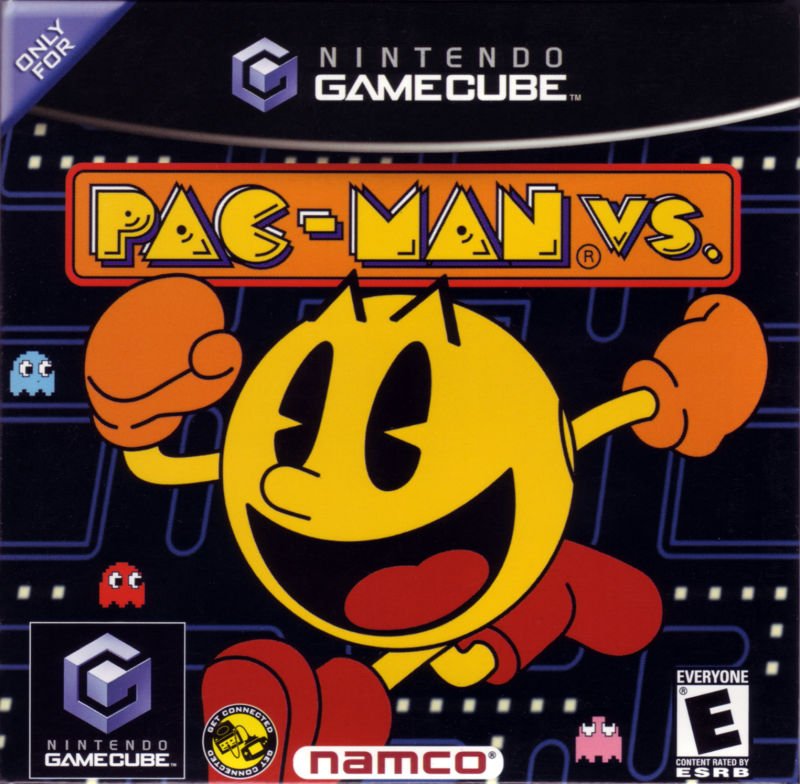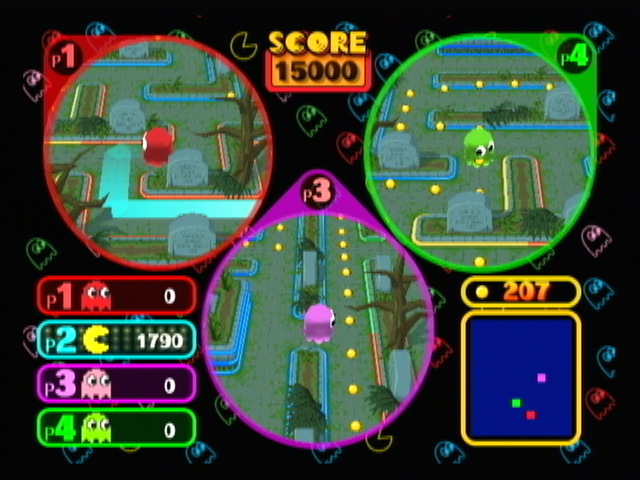Pac-Man Vs. review
Do you remember the days of GameCube-Game Boy Advance connectivity? That strange time in the early aughts when Nintendo pushed some genuinely unique—and often very weird—game designs based on hooking up a GBA to your GameCube through its controller port? Now those were some wild times.
While creativity definitely showed through in certain connectivity-enabled projects, it seemed like Nintendo wanted to shoehorn the gimmick into as many games as possible. And from a business perspective that made sense. Despite being an awesome little console, the GameCube didn’t sell all that well, especially compared to the PS2. When the Xbox started picking up steam, The Little Cube That Could ended up in third place.
But you know what Nintendo product did continue to dominate its market at the time? The Game Boy Advance. If Nintendo could harness the immense appeal of their handheld and channel some of that back into their home console, perhaps it could turn things around. Obviously, in the end GC-GBA Connectivity wouldn't be enough to make the GameCube #1, but it was a hell of a swing. And we sure got some interesting games out of it. Pac-Man Vs., for example.
Pac-Man Vs. was first made available in North America as a free bonus, part of a limited-time promotion. In November 2003, when players purchased the GameCube versions of R:Racing Evolution or I-Ninja at a video game retailer like EB Games, they would receive a Pac-Man Vs. disk for free. Less than a month later, the game would be available for purchase as part of the Pac-Man Vs./Pac-Man World 2 two-games-in-one package—which is how I came into possession of this gem.
Leaning into the asymmetric gameplay made possible with GC-GBA Connectivity, Pac-Man Vs. presents a truly unique multiplayer experience. One player plays Pac-Man while the other players take on the role of one of the ghosts. Or actually, to be more precise, each player plays a different color ghost, and for each round, one of those ghosts gets to play the role of Pac-Man. This raises all sorts of existential questions about death and reincarnation in the Pac-Man universe, so let’s not dwell here for too long.
What makes things interesting is that whoever plays Pac-Man uses the GBA as their controller and looks at the GBA screen. On the handheld, this player gets a view of the entire level, basically like playing a regular game of Pac-Man. The three ghost players (using regular GC controllers) look at the TV screen, where each one sees a limited, zoomed-in view of the game level—plus a color-coded radar, which isn’t particularly helpful.
So while Pac-Man can see everything, the ghosts have a more of a challenge in tracking him down. Luckily, Pac-Man leaves a bit of tail behind him, a handy indicator to the ghosts of where he was last located. Ghosts can also eat the fruit in this game, which gives that particular player a greater range of sight/zoomed-out view for a short period of time.
The ghost who gets to play Pac-Man is selected randomly for the first round. After that, the ghost who catches Pac-Man gets to take on the role for the next round, like a game of Pac-Tag. Points are awarded for eating stuff (dots, power pellets, fruit, ghosts) as Pac-Man, and also for catching Pac-Man when playing as a ghost. The first player to reach a specific point total is declared the winner.
This game uses one connected GBA and up to three GC controllers, and due to having to swap who plays Pac-Man, a different player might be using the GBA every round. The resulting situation is what I like to call controller musical chairs. While you might start using the controller in the P1 slot, after a round or two you might use the P3 controller, then the GBA (P4), and so on. You really have to pay attention to your ghost’s color and not the specific controller port you’re using, which can be disorienting at first. Still that’s all part of the fun.
Also, original GameCube controllers did not have very long cords, and the GBA connection cables are similarly short. The wireless Wavebird controllers have always been notoriously hard to come by. So depending on how quickly your rounds of Pac-Man Vs. go, you can end up a big old tangle of cords to deal with. But again, this is all part of the fun.
As mentioned above, each player takes on the role of one of the four classic ghosts from Pac-Man: Red (Blinky), Blue (Inky), Pink (Pinky), and…uh…Green. Wait, where’s Clyde? The original orange ghost, known for being the dumb one, is not in this game. Clyde has apparently been replaced by a stylish new green specter. I mean, I’m fine with that—I like green—but this change feels like an odd move. Especially from a color blindness accessibility standpoint, having a red ghost and a green ghost doesn’t seem helpful.
Pac-Man Vs. was actually developed by Nintendo, directed by the most famous game designer of all time, Shigeru Miyamoto. The creator of Mario, Zelda, Donkey Kong, etc. personally crafted this quirky take on Pac-Man, and I dare say he did an excellent job. Of all the GC-GBA Connectivity games, it has to be in the Top 3. That’s not a high bar necessarily, but I genuinely think this game is the best justification of the gimmick.
Miyamoto’s team did make one extremely odd choice with this game though, and that was using Mario as the narrator. That’s right, Super Mario (as voiced by Charles Martinet) narrates everything in Pac-Man Vs., despite never once appearing on-screen. I suppose this was a fairly ‘talky’ era for Nintendo—Super Mario Advance characters wouldn’t shut up and Super Mario Sunshine had fully-voiced cutscenes after all—but having Mario call the action in a Pac-Man game is rather baffling. After one or two rounds, clips of Mario saying “Pac-Man ate a power pellet!” will be forever burned into your psyche. Then, after just a game or two, hearing Mario’s voice ceases to be weird at all.
Still, even with Super Mario’s disembodied voice ringing in my ears, I can’t deny that this is an incredible game. Getting friends together around the GameCube and passing the GBA around in that dance of controller musical chairs is way more fun than it has any right to be. Pac-Man Vs. is a truly special kind of multiplayer experience, one only made possible through GameCube-Game Boy Advance connectivity, and thus something that’s fairly hard to come by, especially 20 years after its release. But if you can gather all the hardware necessary to make it work, this one is an all-time winner.
Photo credit: MobyGames









